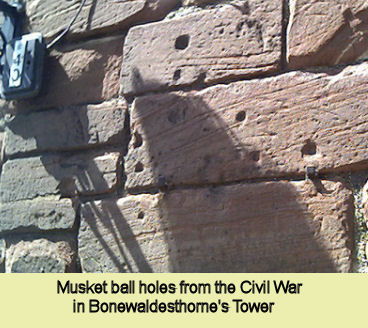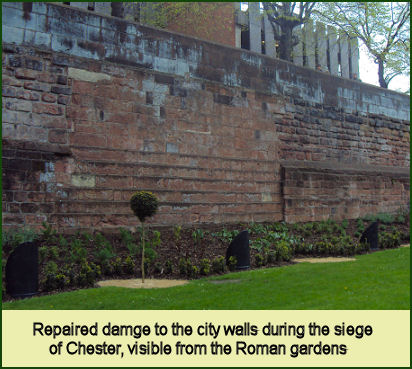The Siege of Chester
 The Siege of Chester took place during the English Civil War, between February 1645 and January 1646, with an intermission during the summer of 1645.
The Siege of Chester took place during the English Civil War, between February 1645 and January 1646, with an intermission during the summer of 1645.
Chester had been a stalwart Royalist stronghold from the beginning of the war. Its circuit of defensive walls was repaired and strengthened during 1642-3 and an outer ring of earthwork defences was constructed. Following his defeat at the Battle of Nantwich in January 1644, the Royalist commander Lord Byron withdrew to Chester from where he continued operations against Sir William Brereton, the Parliamentarian (Roundhead) commander in Cheshire.
Parliamentary forces gradually gained control of much of Cheshire during the early half of 1645, but the Royalists still held the crossing of the River Dee at Chester which gave access into north Wales. After his defeat at Naseby, Charles' hopes were focused on reinforcements from Ireland or of a junction with Montrose in Scotland. Chester was to become the key to both strategies.
In February 1645 Sir William Brereton mounted a assault on the city, and made an unsuccessful attempt to scale the walls near to the Northgate but was repulsed. Now the last port still in Royalist hands, the Parliamentarians laid siege to the city in December 1644 and set up a close blockade of the city. In March, King Charles I's nephew, Prince Maurice of the Palatinate, arrived in attempt to relieve the city but left in April taking with him a large part of the garrison. Chester was left with only some six hundred regular soldiers to defend it, together with those of the city's population who were capable of bearing arms.
On 20th September 1645, a force under the command of Michael Jones made a determined attack on the Royalist barricades under cover of darkness, which took the city's Royalist defenders totally by surprise and caused the Mayor to flee from his home in Foregate Street . Jones forces stormed the eastern suburbs at dawn, gaining control of the district outside the Eastgate and the Royalists were forced to fall back back to the inner city.
 Parliamentarian artillery began bombarding the city on 22nd September and after making a breach in the city walls they attacked in two places. Both attacks were repulsed by the Royalists. St John the Baptist's Church was severely damaged by the Parliamentarians during the siege. Its western transepts were reconstructed in the 19th century. The guns at St. John's were turned on the Dee Mills, the Bridgegate waterworks, and the south-east corner of the walls.A cannon battery placed in St John's churchyard breached the city walls near the Roman amphitheatre. A hole some 25 feet wide was made in the wall. Repairs made to this breach in the wall are still visible to the present day, in the section next to the Roman Gardens. During the siege, the Royalist Captain Morgan positioned guns on Morgan's Mount, a tower on the city walls. Skeletons were actually discovered beneath the walls there when the Chester Canal was being dug.
Parliamentarian artillery began bombarding the city on 22nd September and after making a breach in the city walls they attacked in two places. Both attacks were repulsed by the Royalists. St John the Baptist's Church was severely damaged by the Parliamentarians during the siege. Its western transepts were reconstructed in the 19th century. The guns at St. John's were turned on the Dee Mills, the Bridgegate waterworks, and the south-east corner of the walls.A cannon battery placed in St John's churchyard breached the city walls near the Roman amphitheatre. A hole some 25 feet wide was made in the wall. Repairs made to this breach in the wall are still visible to the present day, in the section next to the Roman Gardens. During the siege, the Royalist Captain Morgan positioned guns on Morgan's Mount, a tower on the city walls. Skeletons were actually discovered beneath the walls there when the Chester Canal was being dug.
Randle Holme (1627-99) the son of a royalist Alderman of Chester during the Civil War vividly records the damage caused by the siege for posterity-
"Thus of the most anchante and famous cittie of Chester, in times past; but now beholde and mark the ruines of it in these present times, within these few years, namely, within these three years, 1643, 1644, 1645, the particular demolitions of it, now most grievous to the spectators, and more woefull to the inhabitants thereof.
King Charles I arrived at the city from Hereford on 23rd September, he entered through the Bridge gate and stayed the night at the Mayor, Sir Francis Gamull's house on Lower Bridge Street. The Jacobean hall where Charles stayed is now covered with a later brick facade, a carved statue of Charles I on Bridge Street still marks this event. The king ordered 3,000 horse under the command of Marmaduke Langdale to camp outside the city while he and 600 others entered Chester. His intent was to attack the besieging Parliamentarians from both sides.
Having lost the resultant battle of Rowton Heath, which he watched from the Phoenix Tower on the city walls, On 25th September Charles fled Chester on 25th September. The king managed to slip out of Chester the following day via the Old Dee Bridge, retreating to Denbigh then to Newark. Lord Byron refused to surrender the city. The Parliamentarians constructed siege works to encircle the city and maintained a constant bombardment. The city's defenders repulsed attempts to take Chester by storm but conditions within the city worsened as winter set in and its citizens were forced to eat cats, dogs and even rats to survive. With many of its citizens citizens dead or dying of starvation, Chester finally surrendered to the Parliamentarians in January 1646. Sir William Brereton's forces occupied Chester on 3rd February 1646.
Further Civil War reading
The Civil War Massacre of Barthomley and skirmish at Haslington
